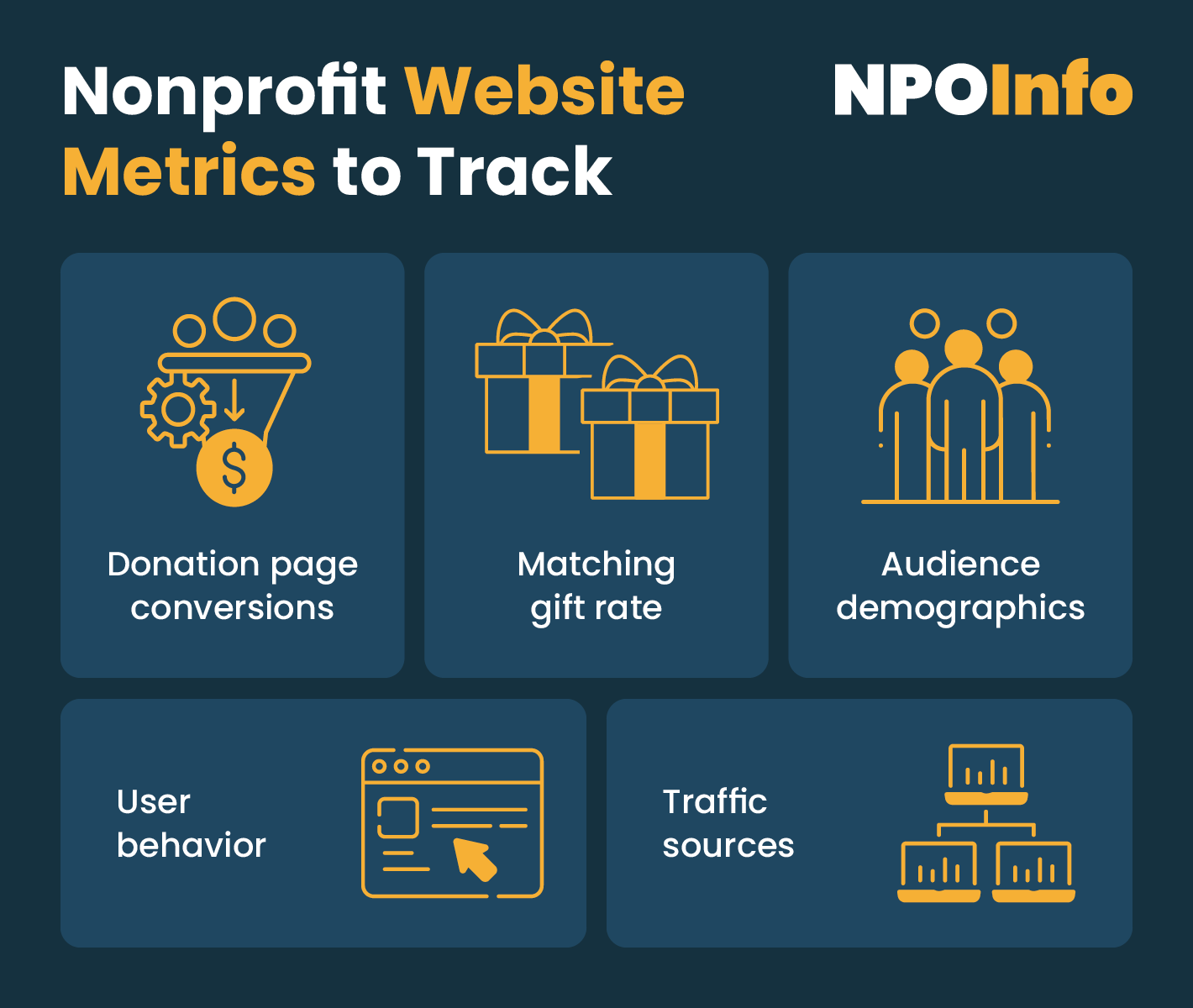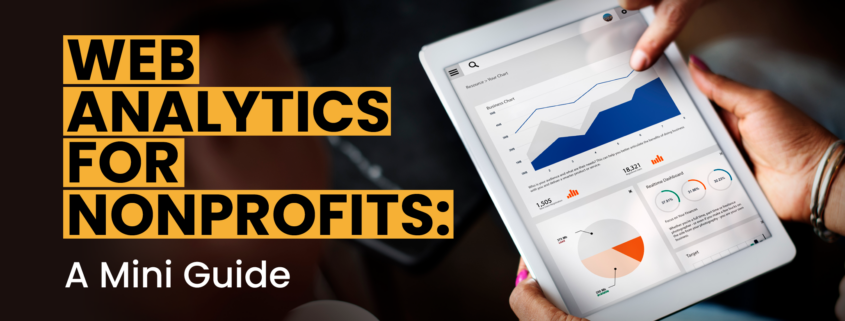Web Analytics for Nonprofits: A Mini Guide for the New Year
Web analytics help your nonprofit get to the heart of how supporters feel when they interact with your website. Curious about the impact of your marketing efforts on donation conversions? Want to know whether your calls to action (CTAs) are effective for driving engagement? A clear web analytics strategy can answer these questions and many more.
The new year means new data collection challenges and opportunities for nonprofits. In this brief guide, we’ll provide an overview of how you can set up your web analytics strategy to improve your data-gathering approach as we head into 2024. Here are the top five tips that will support your strategy:
1. Track the right metrics
There is such a thing as too much information when it comes to tracking metrics. Too much data can clutter your reporting processes and distract you from your highest-priority concerns.
Instead, keep your focus on the data points that are most relevant to your goals. These metrics might include:

- Donation page conversions
- Matching gift rate
- Audience demographics
- User behavior
- Traffic sources
You can use a combination of your content management system (CMS), user behavior tools like HotJar, and analytics tracking systems like Google Analytics 4 (covered in the next section) to assess these metrics.
You can also use data-gathering tools like forms or surveys to gather data from supporters directly. Make sure these tools only ask for the necessary information that will support your data-collection goals. Eliminate any questions that lead to unnecessary information that will clutter your database.
Evaluate your metrics regularly using reports and assign staff members to implement strategy changes based on positive or negative trends. For example, perhaps you notice a major drop in donation page conversions in the early winter months. In that case, you could explore winter-themed fundraising ideas that drive engagement, such as a festive eCard campaign or holiday-themed text-to-give campaign.
2. Make the most of GA4
In the summer of 2023, Google stopped processing data in Universal Analytics to make way for the new GA4 platform. This was a major change for marketing professionals who had been using the Universal Analytics model for 11 years.
As you get your GA4 dashboard up and running, make the most of this new model with the following tips:
- Familiarize yourself with the new functionality. According to Kanopi’s GA4 overview, this new model offers multiple updated features for web professionals to take advantage of. GA4 enables users to track users across multiple websites and apps, leverage AI and machine learning instead of cookies, and access greater insights into how marketing efforts impact conversions.
- Set up custom reports. You can develop up to 150 custom reports in GA4. Carefully choose variables such as the dimensions, metrics, and date range for each report to capture the insights that matter most to your nonprofit.
- Conduct team training as needed. Since GA4 is still relatively new, your marketing team may need some time to get familiar with the platform. Conduct a few training sessions so that team members know how to make the most of the platform. Consider working with a nonprofit web design professional to host these sessions. These experts know the ins and outs of GA4 and can help your team get up to speed quickly.
Make sure your CMS is fully integrated with GA4 to streamline your analytics tracking. GA4 integrates with most major CMS platforms like Drupal and WordPress.
3. Prioritize personalized web experiences
As we move into the new year, personalization will only become more important for nonprofits. 69% of consumers want personalized and consistent marketing experiences across multiple marketing channels, including digital platforms.
The following strategies help nonprofits leverage web analytics for a personalized experience:
- Use analytics to design an experience that’s personalized to different audience segments. For example, you can use GA4 to identify which supporters prefer giving via mobile device or desktop. Then, you can follow up with these individuals and promote different giving opportunities based on their preferences.
- Prioritize a positive user experience. Use analytics and user behavior metrics to understand how visitors are engaging with your website, which pages they tend to linger on, and the pages that aren’t as successful in capturing their attention. Dig deeper and use heat map tools to understand what page elements make for a compelling web page.
- Make your CTAs more specific. Identify your primary audience segments by analyzing user research and audience personas. Then, develop a CTA strategy that speaks directly to the motivations and needs of each group. For example, you can create CTAs that encourage people to donate, register to volunteer, or become an advocate.
One of the advantages of new tracking tools like GA4 is that they enable greater personalization without compromising donor privacy. For example, GA4 doesn’t store IP address information, granting users greater anonymity. Instead, it leverages machine learning techniques to help fill any gaps in data collection.
4. Keep up with data privacy regulations
As data analysis and machine learning tools evolve, legal regulations surrounding data privacy and consumer protections are becoming more common. It’s important to stay aware of any data privacy and security legislation your nonprofit might be subjected to.
These regulations typically depend on the geographic location where you carry out data collection and fundraising. Some laws you might need to comply with include:
- The General Data Protection Regulation (GDPR) in the EU
- The Personal Information Protection and Electronic Documents Act 2000 (PIPEDA) in Canada
- Statewide regulations in the U.S., like the California Consumer Privacy Act (CCPA)
Consult with your legal team for a full understanding of the privacy regulations your nonprofit is subjected to and how you can adjust your data collection processes for full compliance.
Also, be sure to maintain data hygiene to support a clean, uncluttered, secure database. Incorporate regular data backups and security updates as part of your data hygiene procedures to keep data safe.
5. Leverage integrations
Integrate your web analytics and reporting processes with your nonprofit’s other software solutions, like your CRM and marketing platforms. This enables seamless cross-platform data collection and analysis.
According to Bloomerang’s nonprofit CRM guide, integrations can save nonprofit staff members’ time and minimize data transmission issues. Plus, you can use data to create more personalized marketing outreach, improving your donor cultivation efforts and encouraging more donors to stay involved long-term.
For example, let’s say you want to create an online campaign to engage younger donors. Here are a few ways integrations can support this goal:
- Using your web analytics and data-gathering tools, track behavior patterns for younger website visitors, such as the pages they browse the most or their giving preferences.
- Combine this information with the data in your nonprofit CRM to create a user persona for your younger audience members. The persona should include information about users’ ages, online behaviors, reasons for engaging with your organization, and ideas for messages you can use to connect with them.
- Then, design a multichannel marketing campaign using marketing integrations such as your email or social media marketing platform. Reference the information gathered in your personas to reach out with tailored messages that consider younger supporters’ interests and giving habits.
Speaking directly to supporters’ interests builds stronger bonds and long-lasting connections.
Growing your website from a standard platform to a truly great online resource doesn’t happen overnight. Understanding and implementing these tips now will set your organization up for success and provide the foundation you need to expand your fundraising efforts.




